
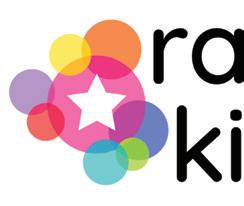





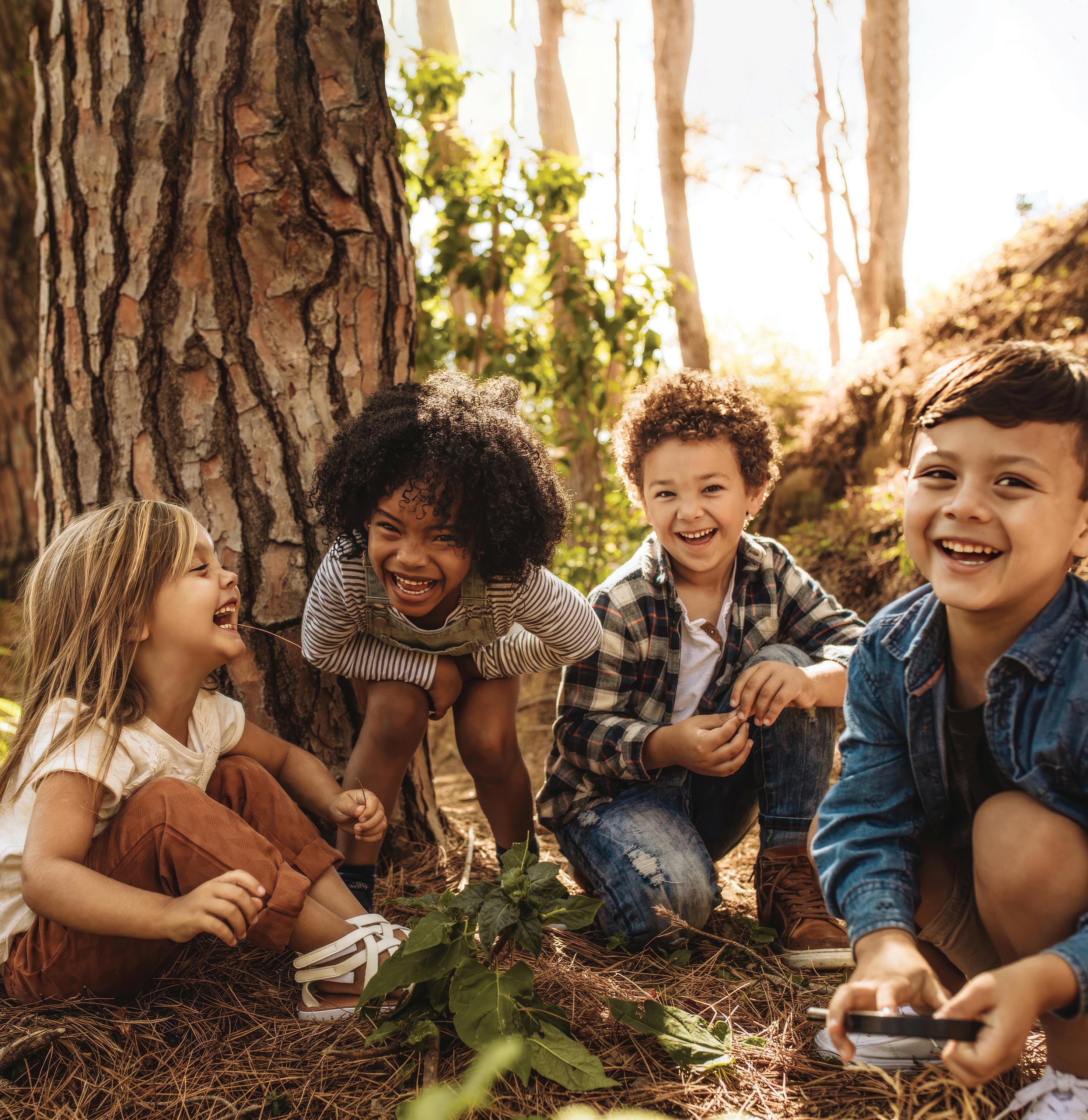
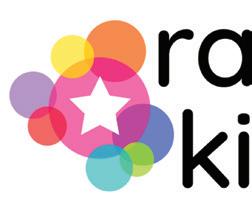

Copyright © 2024 Rayz Kidz LLC
All rights reserved. Tis book or any portion thereof may not be reproduced or used in any manner whatsoever without the express written permission of the publisher except for the use of brief quotations in a book review.
www.rayzkidz.com
With gratitude and appreciation for the Child Care Providers United (CCPU) organization whose hard work and advocacy provide access to resources such as these. To the team at the CCPU Training Fund for your partnership, input, and support in bringing this important resource to life.
To all home-based child care providers helping raise the children of the next generation. We are in awe of your skills and your dedication; we are honored to support you.
To the children in our lives, our forever inspiration, motivation and the best validation of the importance of play in early childhood.
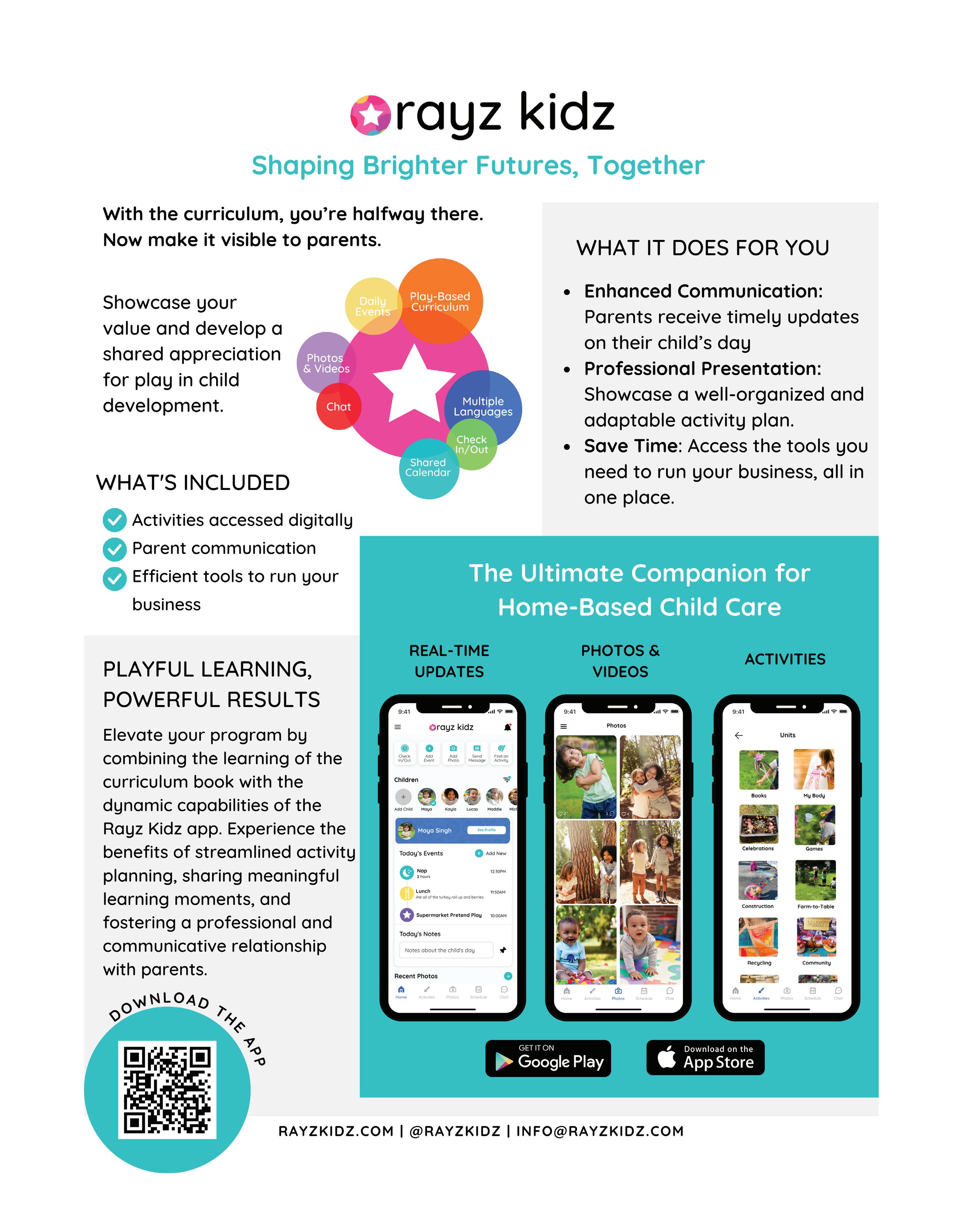
Rayz Kidz is a digital platform, app, and curriculum designed to support home-based care providers, enhance family engagement and provide high-quality educational resources. Te app and curriculum, created by a team of educators and parents, aims to make early childhood education more accessible and efcient for families and caregivers, leveraging new approaches and modern technology to support child development and communication.


Tis book is designed for early child care providers and educators of young children who value play-based learning. With this book, you will be able to implement or maintain a play-based pedagogy in your program efciently and efectively. You’ll engage children in a day full of playful learning, support age-appropriate development, and gain the language to explain and advocate this approach to parents and other key stakeholders, ensuring you are respected and valued.
Whether you are an experienced provider who has witnessed the benefts of play-based learning, or a newcomer who intuitively feels that play is essential, this book will be your guide to a playful pedagogy. It ofers both the scientifc foundation and practical activities to implement this methodology in your program. Troughout the 12 units of the book, you’ll fnd a variety of subjects and activities designed to serve as your comprehensive curriculum for a year or more.
Te core principles of all activities include:
• Experiential learning
• Engaging content
• Simple setups
• Resourceful materials
• Open-ended play
• Accessible for children of all abilities
Each activity comes with a facilitation guide that identifes the domains and skills that are being naturally exhibited or developed with your guidance. Tese guides include prompts for engagement to maximize learning or for observations to efectively extend the activity and learning.
While this book is useful in any early childhood setting, it was specifcally designed for home-based providers of mixed-age programs. Home-based providers face unique challenges such as limited resources, but also have unique opportunities, like autonomy over their schedule and environment. Our goal is to address both the challenges and opportunities, inspiring and empowering providers and their programs to thrive.
We are proud to be your partner in play-based pedagogy and ofer additional tools through our mobile app, Rayz Kidz Te app provides even more play-based activities, easy ways to share with parents, and features to document daily photos and events. It serves as your all-in-one child care management system and curriculum: Te Ultimate Companion for Home-Based Child Care. Using the app, we encourage you to make your work visible to parents so you can be valued and recognized for the critical role you play in a child’s development.
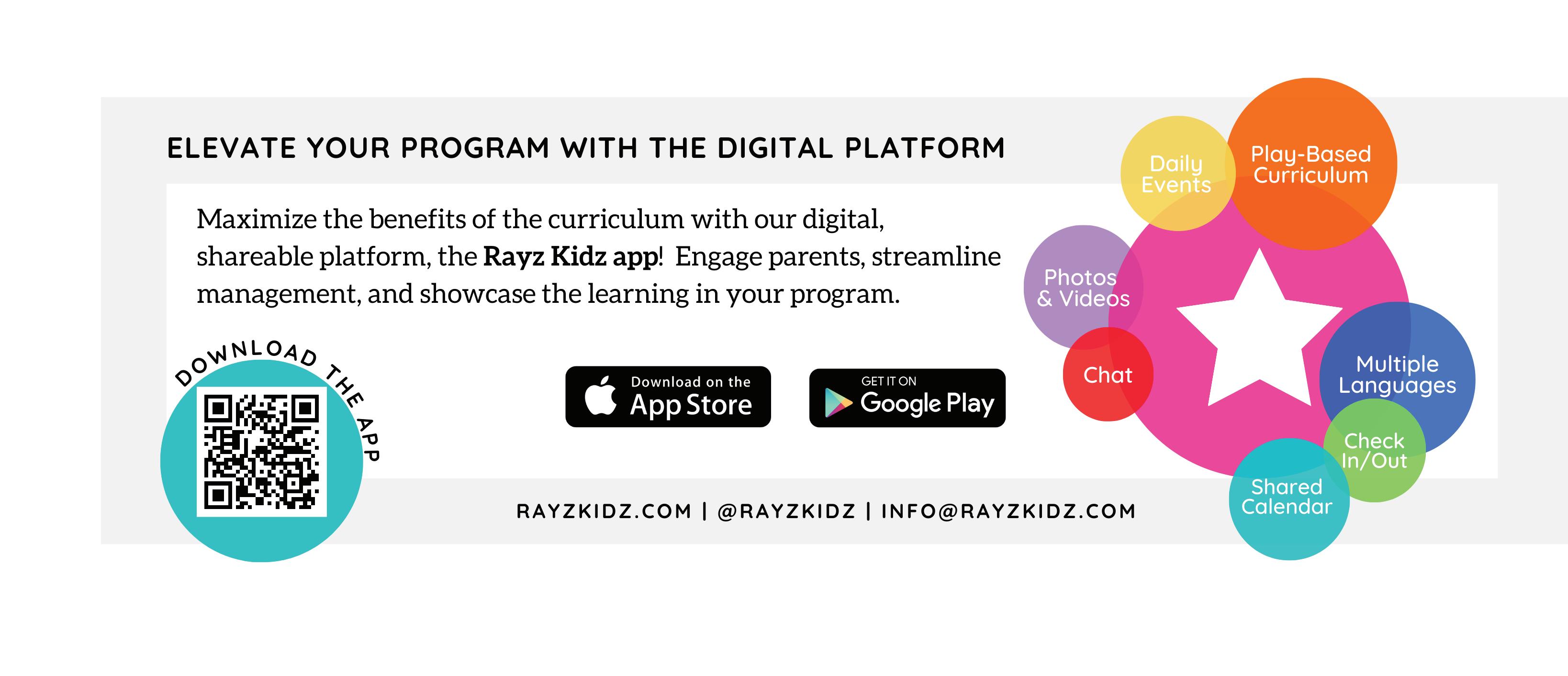
Te curriculum is conveniently broken into a collection of separate books:
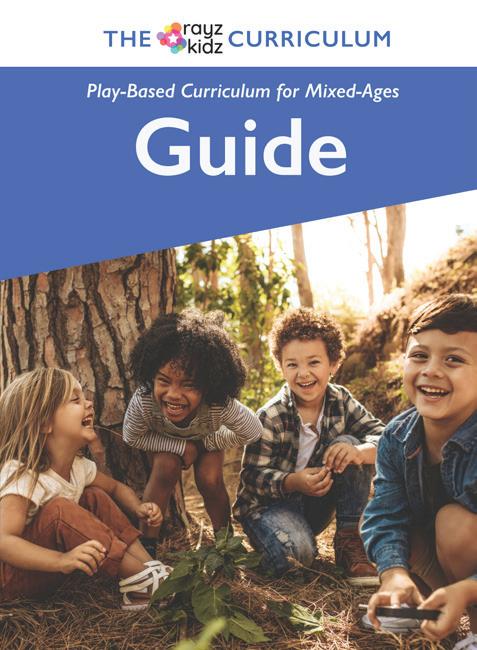
Te Guide Book (this book) serves as your foundation for using the curriculum. It provides both quick reference materials and long-form supporting material that you can easily read through during your downtime.
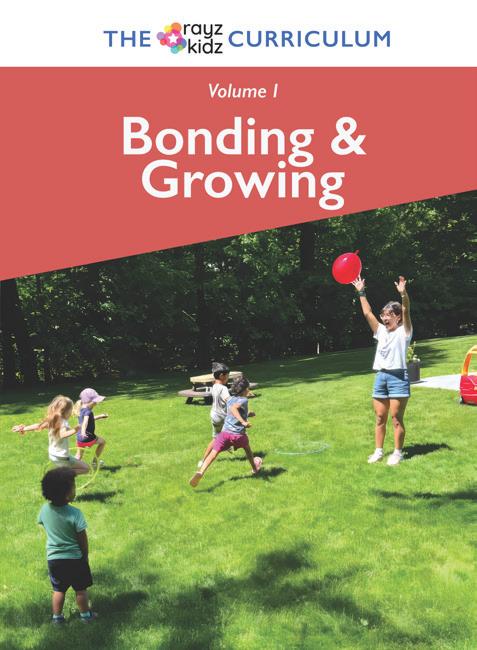
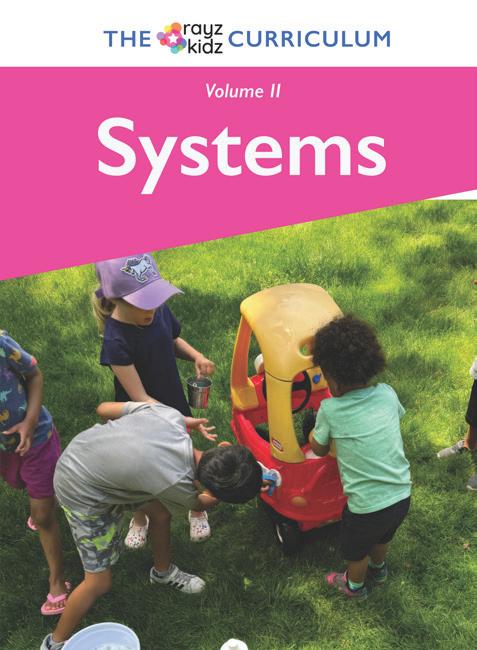
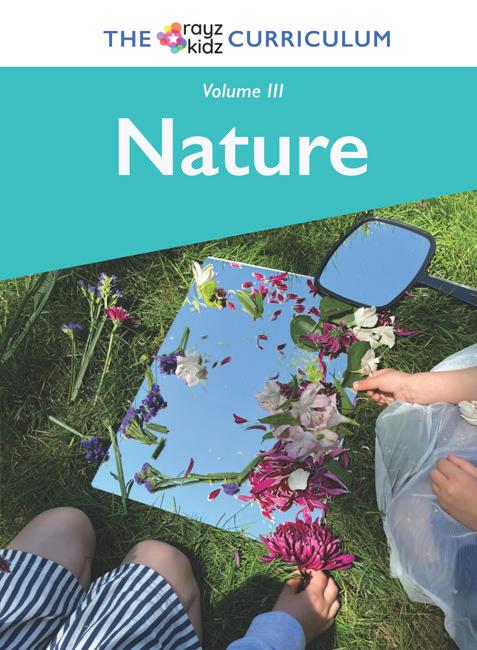
Te twelve curriculum units are grouped together into three overarching themes: Bonding & Growing (Volume I), Systems (Volume II) and Nature (Volume III). Each volume consists of four units, and each unit is further divided into sub-units, with each sub-unit containing fve activities. Altogether, the curriculum includes 265 group activities.
How to Use the Curriculum: We encourage every educator to adapt this curriculum to ft their unique environment. To help you make the most of it, we provide useful suggestions for planning and scheduling the units throughout the year. As some units naturally align with the seasons, we’ve provided a recommended calendar for seasonal planning. In this section, you’ll also fnd an overview of our philosophy that underpins the development of our activities, along with a visual guide to the activities and facilitation guides. For newer providers seeking guidance on daily planning, we’ve included best practices for structuring your day around play.
A Play-Based Pedagogy In Practice: Implementing or maintaining a play-based pedagogy requires the ability to explain and advocate for this approach to parents and key stakeholders. In this section, we delve into the interconnected nature of early childhood learning and the various domains of development. We also discuss the role of adults in facilitating playful learning, the diferent types of play, and how to maintain a balanced approach. Additionally, we cover creative and cost-efective ways to use various materials.
Skills of Early Childhood: From infancy, children begin to develop a set of interconnected skills that lay a foundation for life. Troughout our facilitation guides, we coach educators on the development of 30 diferent skills in the arena of social-emotional, physical, cognitive, and language development, as well as in math and literacy, which falls under our category of school readiness. In this guide book, we expand on each skill and guide educators on how they can foster the development of these competencies through infancy, toddler years, and preschool-aged years. We hope to illustrate the ways that these capabilities build on each other through play and to emphasize how they are connected to success later in life.
Baby Play: While most of our activities are geared toward children ages 18 months—5 years of age, we include a section in this guide book dedicated to defning and defending the importance of play with infants. From the moment that infants are born, their playful and loving interactions with adults lay the foundation for a lifetime of learning. While some of the activities in this section might seem like basic best practices for working with infants, we encourage you to spend time refecting on the value of simple things like face-to-face interactions, reading, pointing, and narrating with young infants. Our facilitation guides, included with each activity, illustrate the importance of these actions as a foundation for children’s social-emotional, physical, cognitive, language development, as well as the early foundations for their math and literacy development. We believe that when educators, parents, and caregivers understand the importance and value of play from day one, it allows us to see how children’s interconnected skills build on each other through play throughout their lifetime.
Basic Recipes: In this section, we have some of our favorite basic recipes for sensory play and cooking activities. Making your own sensory materials can save you time and money and can also open the door to creativity as you make your own version of your favorite sensory materials by adding new colors, scents, and textures. We also love to have easy go-to recipes for cooking together as a way to spend time bonding and cooking with children.
A quick reference table of contents is located at the beginning of each unit. It outlines the sub-units, the corresponding activities, and the classifcation of activity type and setting.
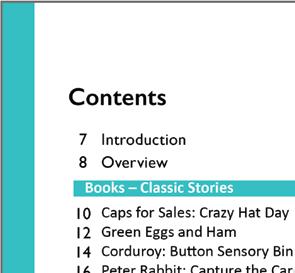
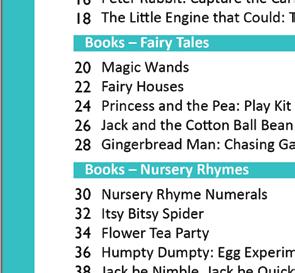
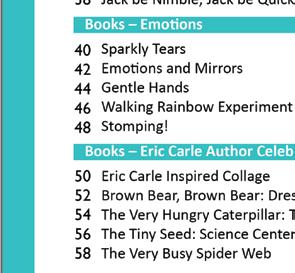
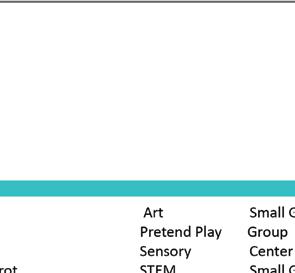
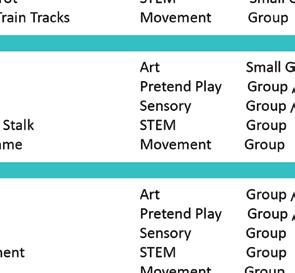
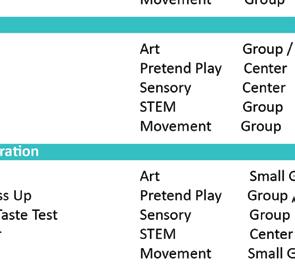



Each unit begins with a summary introduction that explains the importance of the subject matter, ofers recommendations for facilitating, and highlights the core concepts covered in the unit.
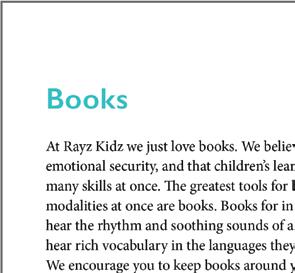

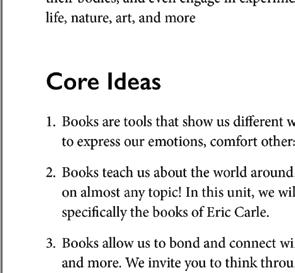
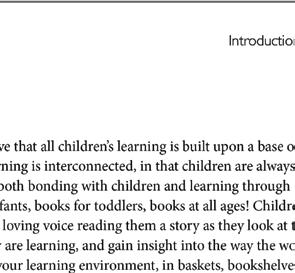
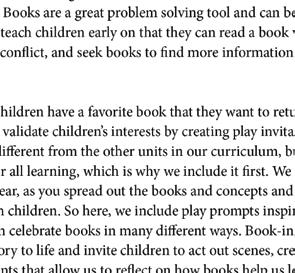
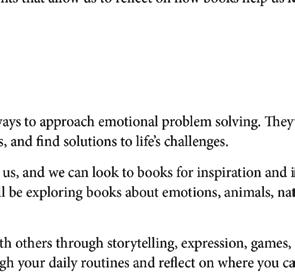



Before the activities is an overview of the sub-units that provides a deeper understanding of the content and helps educators plan how to introduce the material.

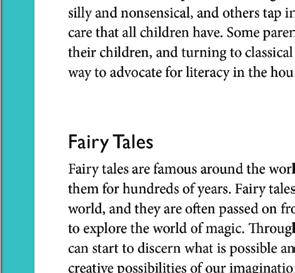
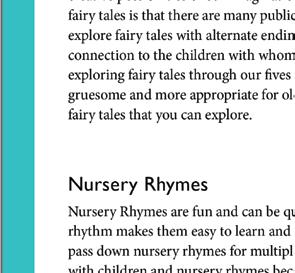
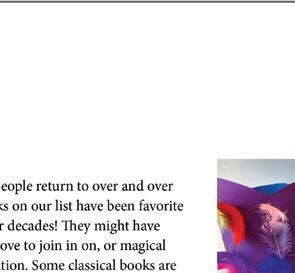
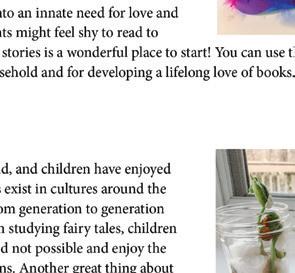
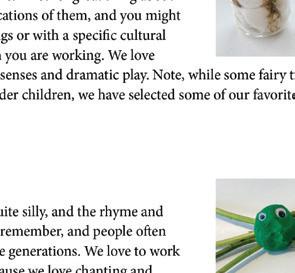


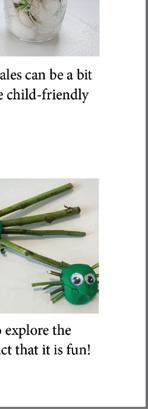

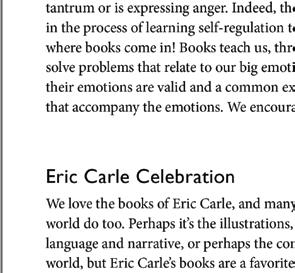
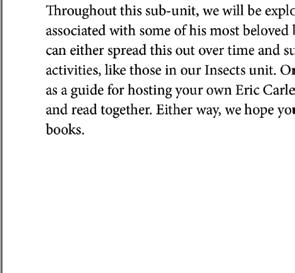
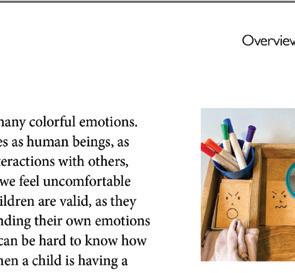
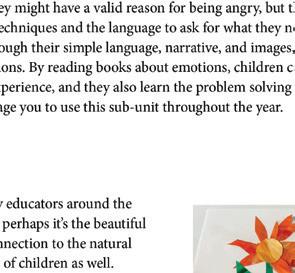
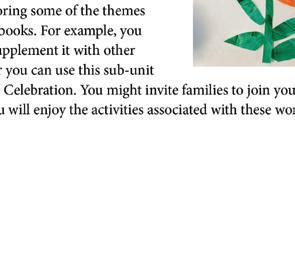



Each activity is visually appealing and includes clear photos showing examples of how it could look. Each activity is organized with a description, step-by-step directions, a materials list and identifed skill development areas.



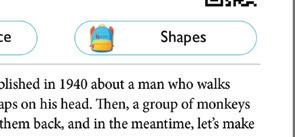



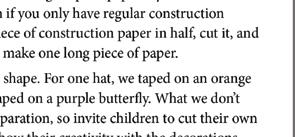



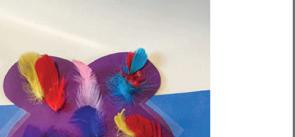


At the end of each curriculum book you’ll fnd a Skill Development Index for each unit. Tis serves as a quick reference guide, allowing educators to select activities that target specifc developmental goals for the children in their care.
Each activity comes with a facilitation guide that highlights three skills being naturally exhibited or that can be further developed with the educator’s involvement. Te guide includes engagement prompts and observations to help extend the learning.



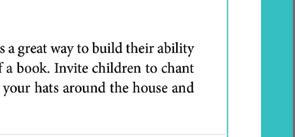

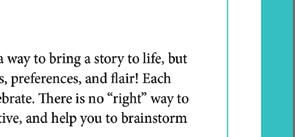








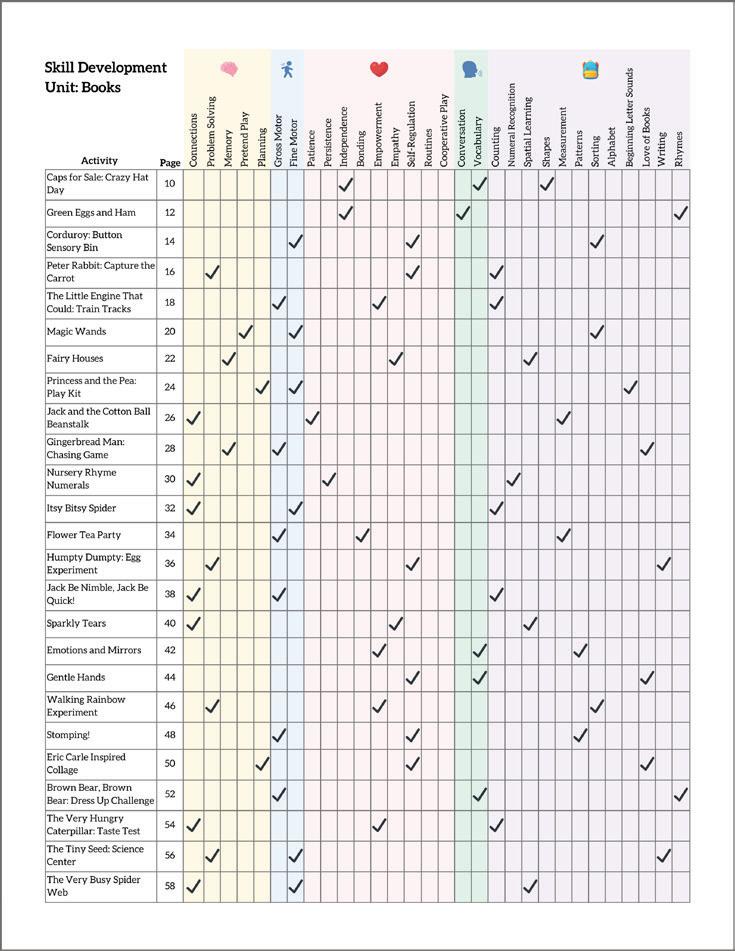
We have organized our curriculum into overarching themes. Tere are many diferent ways to schedule your year. You might explore the units in chronological order or follow a seasonal calendar. Each educator will fnd their own rhythm as the year progresses. But frst and foremost, we highly encourage you to follow children’s interests. For example, let’s imagine that you live near a big construction site that children see on their daily walks. Tey might have a lot of questions and observations as they talk frequently of the big machines, materials, and people at the construction site. In this case, that would be a wonderful chance to explore the Construction unit so that children have multiple modalities through which to explore their questions.
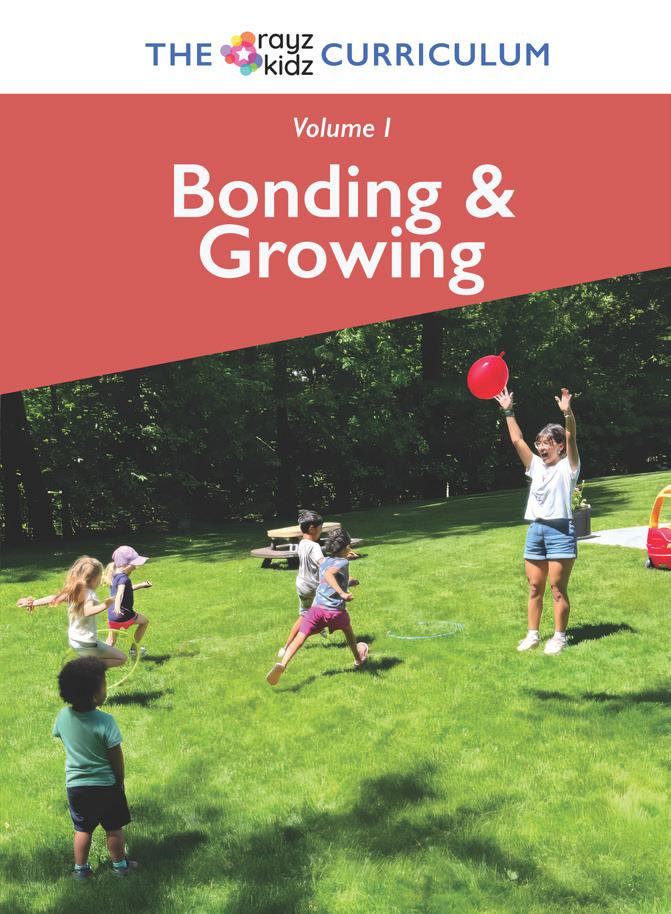
Units:
• Books
• My Body
• Celebrations
• Games
BONDING & GROWING: Children love refecting on their own growth and connections with others. In this book we include our Books, My Body, Celebrations, and Games units. We think that these units are particularly important for understanding the ways that we are growing and bonding with others. For example, the Books unit invites us to explore scenarios related to our own growth, whether we read a book about processing our emotions, learning about bedtime routines, or about hard work. Trough books we also bond with others, whether we are turning to books to learn how to share, or snuggling together to read a book before nap time. In the My Body unit, children will explore their own growth and development as they learn to talk about their growing bodies. In Celebrations, children will understand how celebrations are a part of our growth, as we celebrate our birthdays and the passage of time, and how humans come together to celebrate special occasions. Celebrations are an important part of our sense of belonging and a great way to bond with others. And fnally, Games teach us how to cooperate and play with others, and we see directly how our physical growth and development of skills allow us to learn new and more complex games.
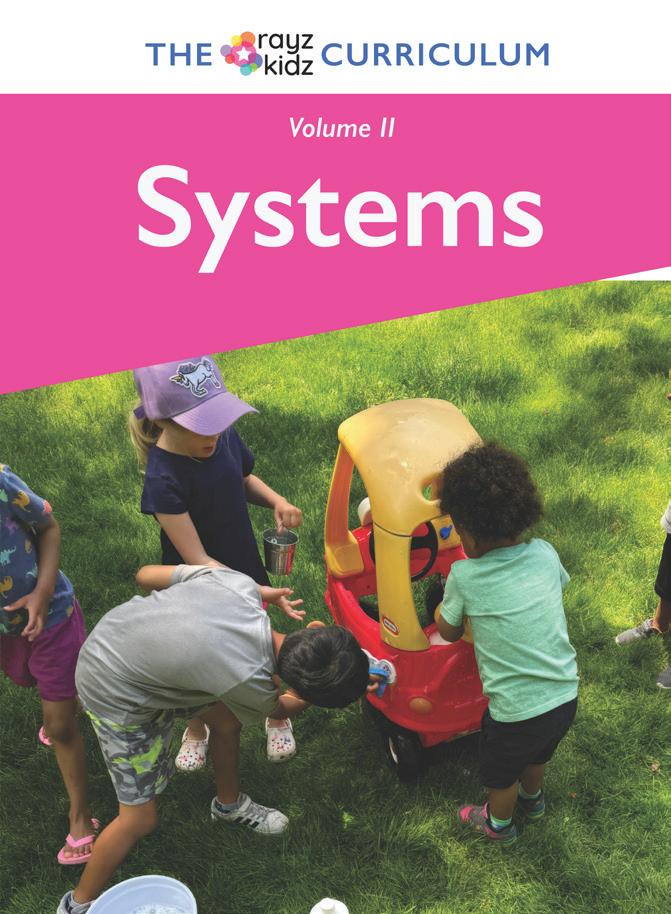
Units:
• Construction
• Farm-to-Table
• Recycling
• Community
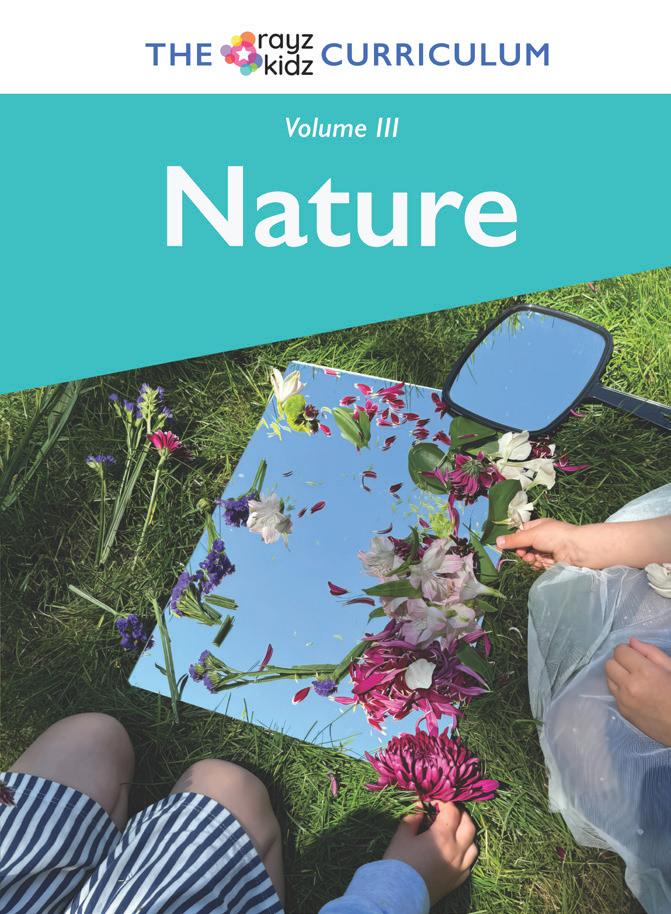
Units:
• Insects
• Flowers
• Water
• Trees
SYSTEMS: Children love learning about the way the world works. Tis book includes our Construction, Farm-to-Table, Recycling, and Community units. To understand the way the world works, we might take a holistic approach to understanding the ins-and-outs of a larger system, rather than looking at just one part in isolation. For example, the Construction unit allows us to understand that the buildings that we live, work, and play in are designed and built in stages that involves many diferent people, materials, and processes. When we think about our food systems, the Farm-to-Table unit invites us to explore the many interconnected parts from farms, to transport, to supermarkets, and to our tables. When we learn about Recycling, we learn that there are complex systems in place to make sure that recycled materials get from our homes to the correct processing center. And when we learn about our Community, we learn about the important people that are a part of our intricate networks of friends, family, and important members of the community who contribute to our well-being and safety.
Learning about nature is so important, and children ofen demonstrate a natural curiosity for learning about the natural world. Tis book includes Insects, Flowers, Water, and Trees as an introduction to learning about some important elements of nature. Te Insects unit invites children to study the insects and learn about what they need to survive and why they are important for the environment. Te Flowers unit invites us to explore the world of fowers, which bring so much beauty to our world. In the Water unit, children can explore all the places where we fnd water and learn about its diferent properties. And in the Trees unit, they can learn about the trees in their local environment and the importance of taking care of them. Indeed, these units on nature are meant to connect children to their local ecosystem, so we encourage you to spend lots of time outdoors, whether that is in your backyard or on walks around your neighborhood, as a connection to nature can instill a deep sense of belonging and connection.
The activities in this book are designed to be openended so that you can return to them for many days and even weeks. This is intentional, as we think deep learning happens when children work on projects over a longer period of time and when they are given time to explore and process their learning. We encourage educators to spend time in observation and see where you might support children’s learning. We highly encourage you to mix and match and seek activities that inspire children’s curiosity.
While it is not necessary to follow any specifc order of units, some activities are well-suited for specifc seasons, and you might select a unit based on seasonality. Here is a suggested seasonal calendar:
A refection on friendships and our place in the world. Tis is great to accompany the beginning of the school year, as many children have siblings who are starting school and are thus exposed to other places in the community on their journeys
While we encourage you to study books all year round, the winter months are a great way to dedicate your time to emphasizing the importance of books as a tool for self-regulation, a sense of belonging, and a way to understand the perspective of others.
Even though many of us are with children throughout the entire year, the start of spring is a great time to think about our growing bodies and refect on all we have learned with time!
We love learning about diferent games this time of year, as this unit is a wonderful excuse to get outdoors and play! While the unit also includes indoor games, we provide many great games that inspire children to move their bodies outdoors.
Tis is great for the changing seasons, though if you live in a place where the leaves do not change colors, do not fret! You can still explore this unit with any type of tree.
Te middle of winter is a great time to study construction, as educators may look for creative ways to get children outdoors and moving. Construction invites us to walk around our neighborhood and observe buildings, and the winter is a great time to do this.
As the world starts to wake up with springtime, we love any excuse to get outdoors and explore. If you pay attention, insects are everywhere, and they are a great way to learn about your local ecosystem.
Te summer is a great time to celebrate! In this unit, we use many natural materials that children can fnd while spending time outdoors, which is a perfect for the summer. Our special week on ice cream is great for a hot July day!
November—Farm-to-Table
Tis unit is wonderful at a time of year when there is an abundance of produce, as it invites children to refect on their food systems. Tis unit is also a great way to establish a routine and habit of cooking together.
Recycling is a great unit to do in the winter, as it invites us to think creatively about materials both indoors and outdoors.
May is a wonderful time to explore fowers, as children may notice changes within days and weeks as the world blooms in the spring. We love this unit as an excuse to use fowers in many diferent ways.
We love studying water in the summer because there is no better excuse to play outside! When children explore water outdoors in warm weather, they get to engage in hours of sensory play and there is less worry about clean-up indoors.
Our philosophy pulls inspiration from a variety of methodologies without adhering strictly to any one philosophy. Under the larger umbrella of play-based learning you will see that we combine principles from Reggio Emilia, Montessori, outdoor learning and nature-based education, emergent curriculum, and project-based learning.
Tis hybrid model encourages exploration and discovery, promoting creativity and critical thinking through child-led, inquiry-based activities. Many of these specifc philosophies might focus on independence, self-directed learning, collaboration, community, or a focus on materials, learning environments, and a connection to nature. Play-based education ties these elements together, ensuring that learning remains joyful and engaging Tis comprehensive approach nurtures well-rounded individuals who are curious, confdent, and connected to the world around them.
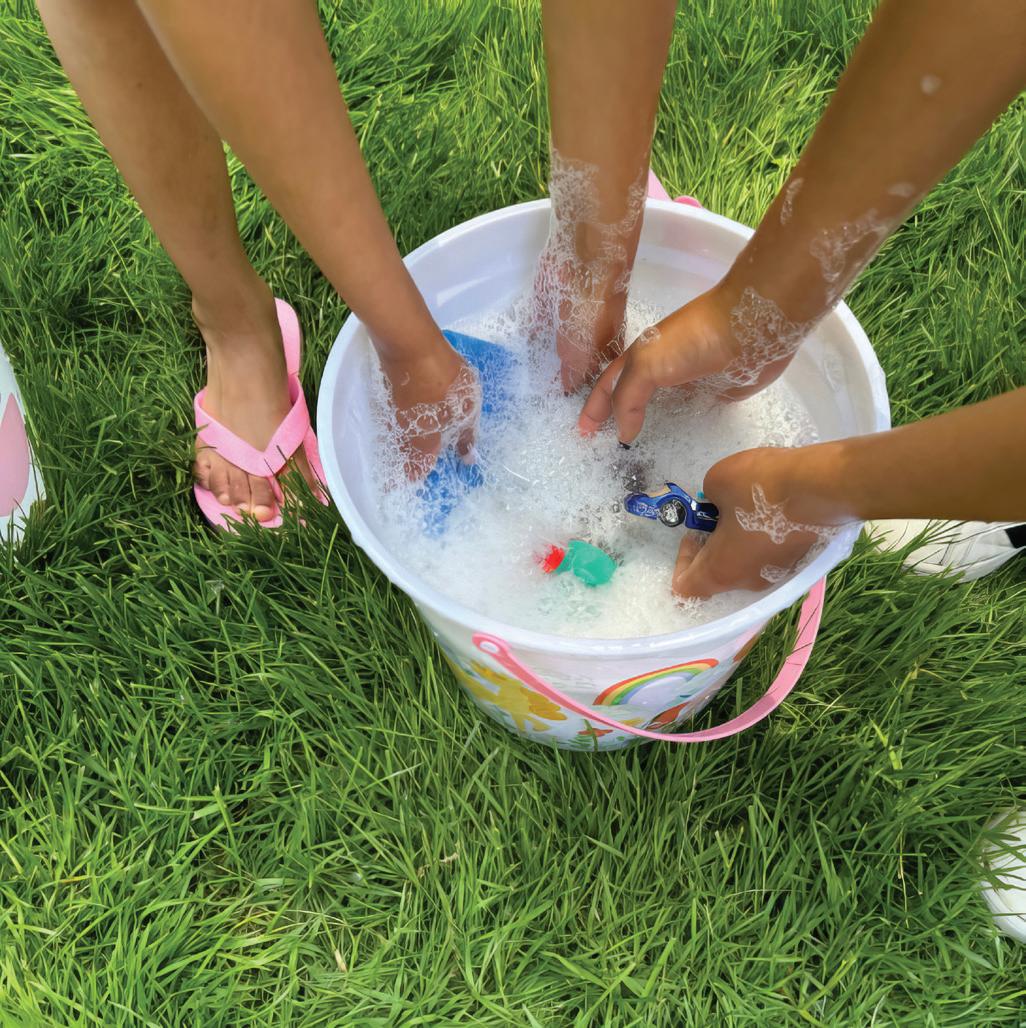
We believe in using materials that are afordable and accessible and hope that through this book you will tap into your own creativity and joy for learning. We encourage you to explore iterations and variations of activities based on children’s interests, your cultural background, or seasonality and availability. For example, let’s take a look at designing learning environments based on children’s interest. If you notice that children particularly enjoy an activity with soapy water, we encourage you to think about where you might use soapy water in other activities, as this might be a sensory need that children are demonstrating. If you are doing a construction unit, you might think about where you can combine construction trucks and bubbles, and use our play prompts from the previous bubbly activity as inspiration to ask your own open-ended questions.
Additionally, we believe in providing educators with activities that all children can participate in, no matter where they are in their development. Every child develops at their own pace, and it is also important to factor in other components of the life of a growing child. All children will come into a learning environment with diferent skills and needs. Whether working with mixed-aged groups, children with developmental delays and disabilities, or children who have experienced trauma, each child is going to have diferent ways of learning and connecting with others. Tat is why we include many diferent types of activities and ways for children to access information at their own pace and level and why we believe in open-ended materials that provide chances for educators to slow down and meet children where they are.

Safety Warnings: Troughout the activites we include prompts for educators to be mindful of safety hazards. Tese are not exhaustive and educators must always use discernment and modify activities and materials appropriately for the safety of the children in their care. Refer to page 25 of the Guide for more safety recommendations.
Te unit and sub-unit the activity is assigned
Each unit will include options to explore core concepts through Art, Pretend Play, Sensory, STEM, Movement.
Here, we highlight three skills being naturally exhibited or that can be further developed with the educator’s involvement.
Tese align to the Facilitation Guide on the subsequent page.
Suggested materials list.
However, we encourage educators to substitute for safety, allergies, availability, and cultural reasons.
Our estimated independent preparation time for the educator.
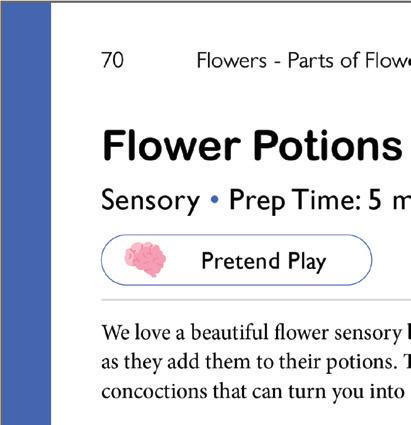
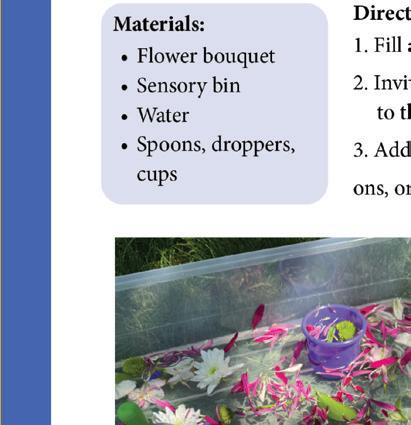
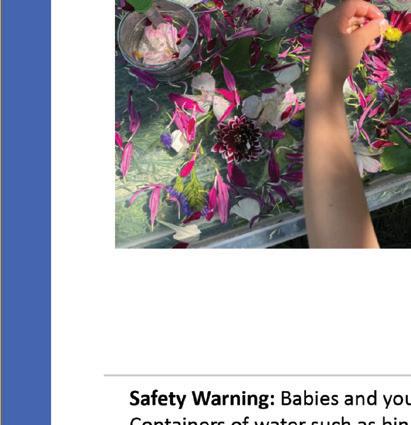
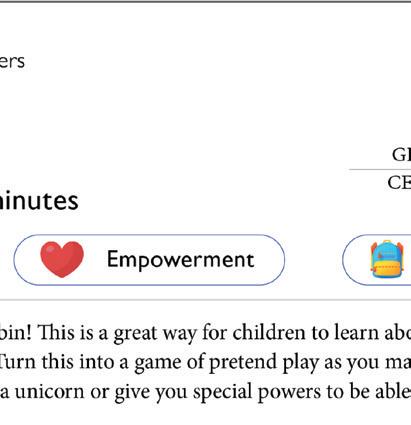
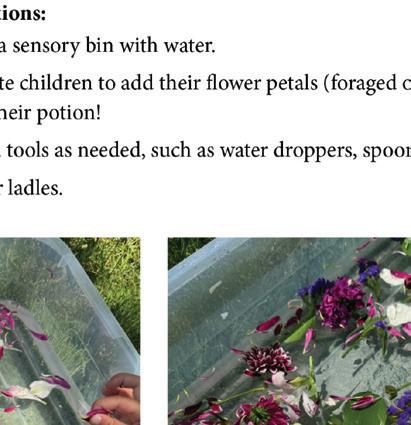
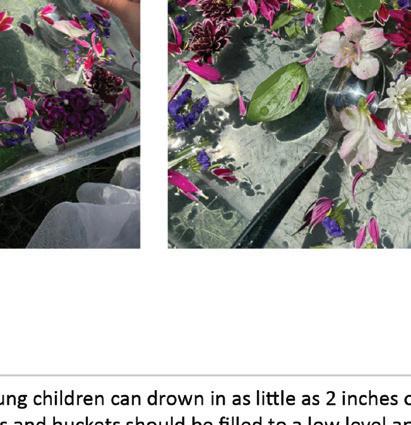

Our recommended setting of the activity. Tese will be either Small Group, Group, Center or Outdoor Center. Many will include more than one option.

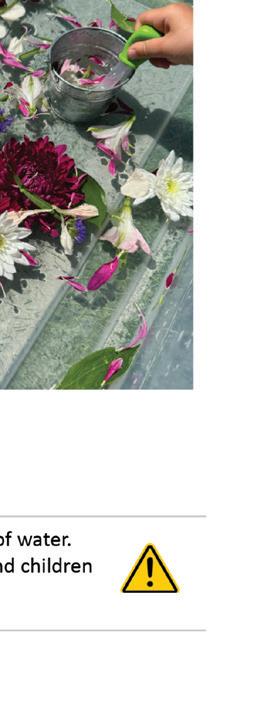
Safety warnings to indicate where educators may need to modify materials or set-ups to ensure the safety of children. Educators must always be mindful of safety and adapt the activity appropriately, even when a safety warning is not listed.
QR code to view and share the activity in the Rayz Kidz app.
An overview of the activity
Step-by-step directions to follow
Clear photos showing examples of how the activity could look. Note: Many of the photos in this book were taken with heavy adult involvement. We encourage providers to celebrate children’s creativity and always focus on process over product.
One of the primary objectives of the facilitation guides is to empower educators to be more confdent in defning and defending the learning that happens through play. Tis confdence helps develop a strong brand and philosophy on play-based education, and that it will help parents understand the value of play as well.
Te identifed domains and skills exhibited or developed. As learning in early childhood is interconnected, we identify three skills for each activity, with School Readiness always being one of the three.
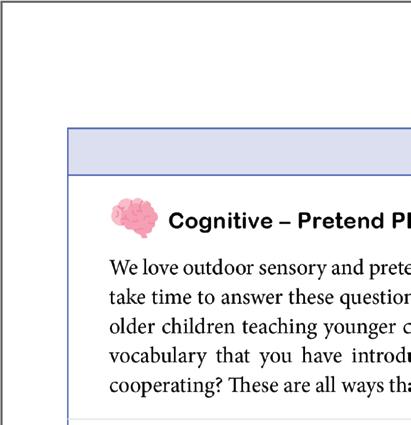
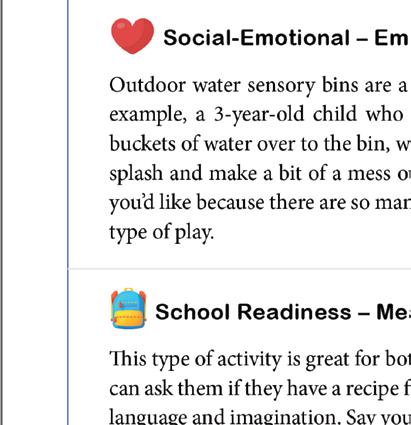
Tip: We encourage you to document and share these with parents using the Rayz Kidz app.
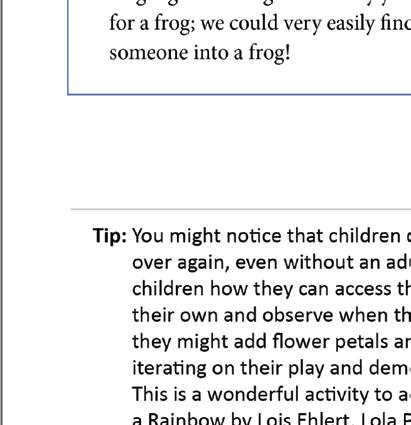
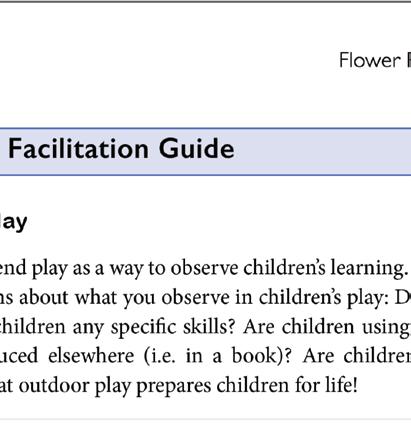
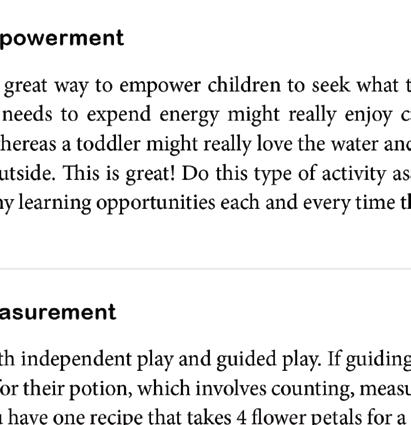
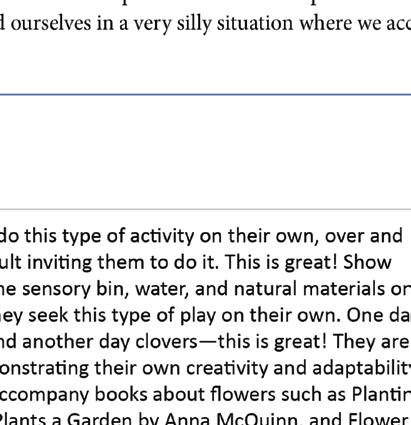









Our tips for efective set up and facilitation, including modifcations, book pairings, or recommendations from our own experience. Connected to the identifed skill, this part of the guide includes engagement prompts and observations to help extend children’s learning. We ofen detail how these skills apply to real life and ofer invitations for educators to refect on the power of learning through play.


Many of the activities might have more than one suggestion, and indeed, we hope that these activities will work in many scenarios in your environment. Being very open-ended, these activities are designed for you to return to over and over again. Here is how we defne and envision each activity use suggestion:
SMALL GROUP: Tis type of activity is well-suited for one on one work with children or with small groups of 2-3 children. Small groups are great for eliciting responses from individual children or for working on specifc areas of development. Say for example that you have a child who is struggling with fne motor skills, a small group activity is a wonderful way to work carefully with them to demonstrate how to grip a marker, lace a string, hold scissors, or how to use a new art material or tool. Additionally, small groups are great when you want to teach the rules of a new board game or work on an individualized art activity.
When working in small groups, it is important to have other interesting activities available for young children, so we encourage you to spend time creating interesting and inviting play centers that children can access independently.
GROUP: Tese activities work well when working with a large group of children. Tis might include a special experience, like cooking together or conducting an experiment, or it might be part of a large art activity, like a group collage. Group activities are wonderful for socialization, and they encourage children to learn about cooperation and participation with peers.
One of the greatest challenges of large group activities lies in ofering diferentiated instruction, as all children will be in diferent areas of development. For example, if you have a 2-year-old child and a 4-year-old child, they will need diferent support during any given activity. Some children might need more physical assistance, while the other children might need more verbal prompting to challenge them or engage their attention. Tat is one more reason why we try to design activities and materials that will engage children by permitting movement and sensory play.
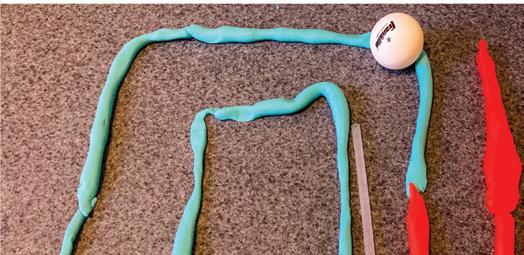


Volume I, p. 164
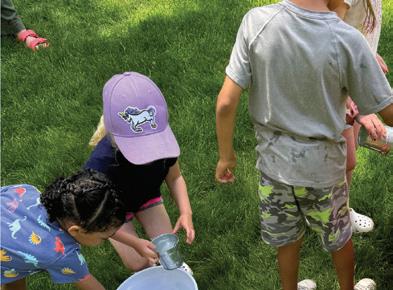
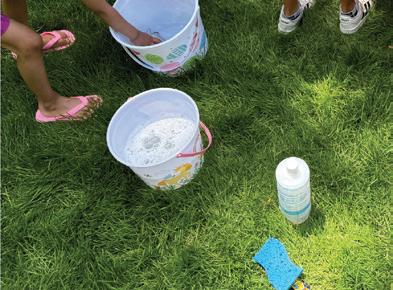
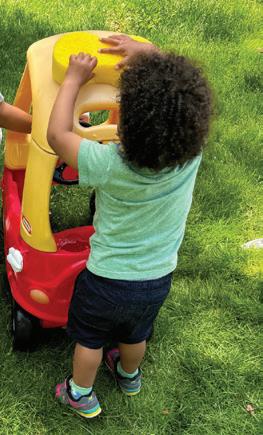

Volume II, p. 202
CENTERS: Creating an inviting learning environment is one of the biggest challenges of working in early childhood education. By organizing a classroom into centers, educators can create a dynamic and engaging learning environment that supports holistic development and caters to the diverse needs and interests of young children. Each center is designed to focus on a particular area of development or subject matter, allowing children to explore and learn through hands-on, experiential activities. Centers can be permanent fxtures in the classroom or can change based on themes, seasons, or curricular goals.
Some types of centers might be a blocks area, a math area, a science area, a reading area, an art area, a sensory area, and a dramatic play area.
We are very passionate about outdoor learning. Tus, we also include ideas for outdoor centers. Outdoor learning can look all sorts of diferent ways. For example, many educators love to take children to engage in free play in natural spaces, whether that is on farms or in forests. However, not everyone has access to safe, outdoor spaces, and one solution is for educators to provide inviting outdoor learning activities for children to explore right in their backyard. Tis might look like games, which would be indicated in our group activities but also could be semi-permanent outdoor centers. Tese are ofen super sensory and involve fun materials like water, mud, buckets, shovels, and collected natural materials. Indeed, many of our activities can be converted to outdoor activities, and we highly encourage you to spend as much time outdoors as you can!
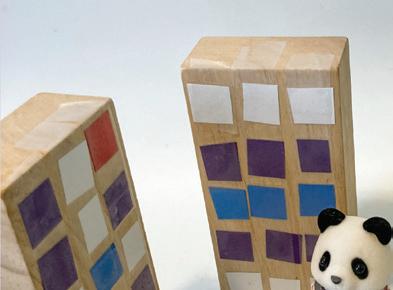
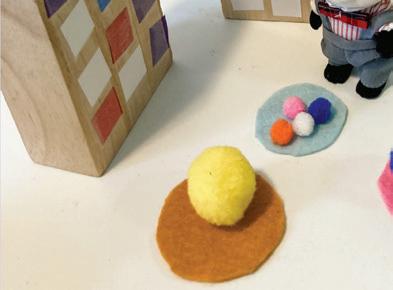
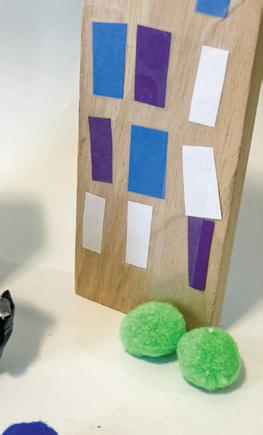

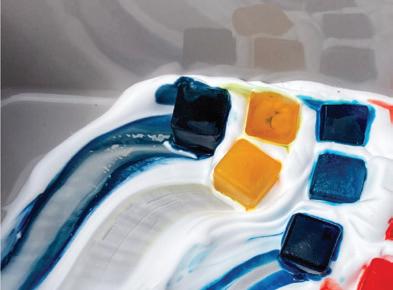

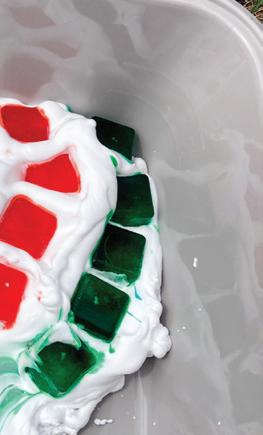
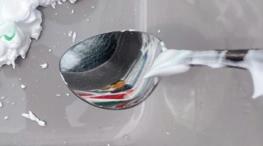
Many of the activities in the curriculum are interchangeable, in that you can use them as both a group activity and a center. Indeed, we hope that the care and love that you put into preparing them allow you to utilize them over days or weeks. You might introduce an activity as part of a Group or Small Group activity and then leave it out as part of a Center. For example, with our “Metal Loose Parts Art,” you might do this activity all together as part of an exploration of metal and then leave the materials on a special tray or in a designated box that invites children to seek that material on their own. You might notice that children use materials in a diferent way than you originally planned or that they might add their own narratives, materials, or ideas to a center or activity. We think this is great! We encourage you to follow children’s lead and observe what actions, concepts, and ideas inspire their curiosity and creativity.
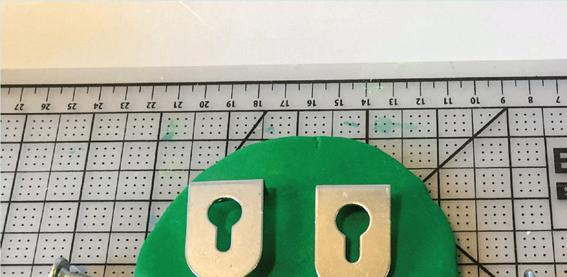
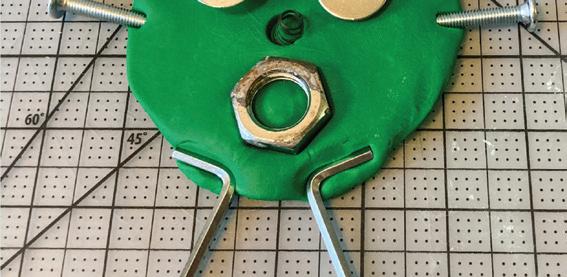


Structure and routines are very important in the lives of young children. Children depend on adults to create a predictable and consistent schedule, as this creates a sense of safety and security. As children become familiar with routines, they gain confdence in their ability to predict and manage their day, which fosters self-regulation and independence. We hope that you will fnd ways to incorporate the activities in this book into your weekly schedule and that you will share this schedule with families and children. Educators may create visuals that indicate when children can expect a type of experience, such as a group activity, outdoor experience, lunch, story time, nap and more. In our sample daily schedule, we have organized the day into blocks that prioritize play with scheduled transitions in between, such as meals and music, to smoothly move from one type of play to the next. Tese consistent transitions act as predictable signals for children, helping them understand what to expect. Tis structure also aids educators in maintaining efective and smooth daily classroom management.
In addition to planning a specifc transition event (e.g. snack time) consider adding a musical representation of a transition indicator. Tis could be as simple as a bell, a timer on a phone, or a special song or movement that represents change in a fun, playful manner such as freeze dance or foor is lava.




Educators working by themselves may fnd it challenging to prepare lunch while meeting the needs of the children. We love using individual sensory boxes for this occasion. We recommend maintaining pencil boxes with safe sensory materials, repurposed from group activities, and making them accessible to children for their independent exploration.




Independent play
Morning circle
Group activity
Morning snack
Outdoor play
Song & dance
Story time
Lunch
Nap / Quiet time
Song & game
Group activity
Afernoon snack
Outdoor play
Pick-up
Educators working with infants on a two-nap schedule may fnd it’s best to pair a group activity during the child’s nap time.
While the Rayz Kidz activities included in this curriculum ft perfectly into the “Group activity” time blocks, they are designed to be repurposed so educators can utilize them throughout the week or even the month in various settings. Many group activities can be converted to centers for exploration during independent or outdoor play.